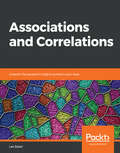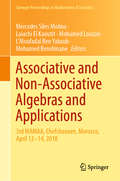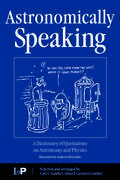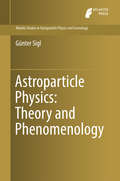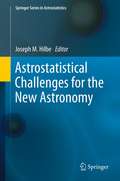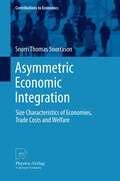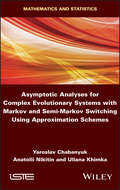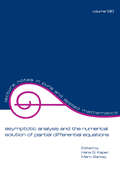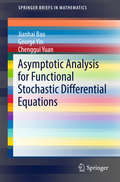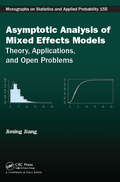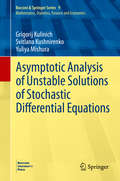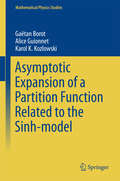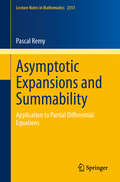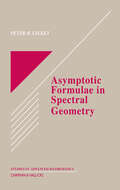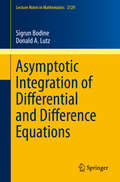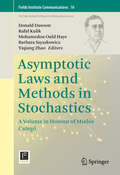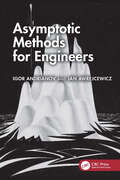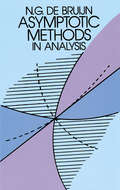- Table View
- List View
Associations and Correlations: Unearth the powerful insights buried in your data
by Lee BakerDiscover the story of your data using the essential elements of associations and correlations Key Features Get a comprehensive introduction to associations and correlations Explore multivariate analysis, understand its limitations, and discover the assumptions on which it's based Gain insights into the various ways of preparing your data for analysis and visualization Book Description Associations and correlations are ways of describing how a pair of variables change together as a result of their connection. By knowing the various available techniques, you can easily and accurately discover and visualize the relationships in your data. This book begins by showing you how to classify your data into the four distinct types that you are likely to have in your dataset. Then, with easy-to-understand examples, you'll learn when to use the various univariate and multivariate statistical tests. You'll also discover what to do when your univariate and multivariate results do not match. As the book progresses, it describes why univariate and multivariate techniques should be used as a tag team, and also introduces you to the techniques of visualizing the story of your data. By the end of the book, you'll know exactly how to select the most appropriate univariate and multivariate tests, and be able to use a single strategic framework to discover the true story of your data. What you will learn Identify a dataset that's fit for analysis using its basic features Understand the importance of associations and correlations Use multivariate and univariate statistical tests to confirm relationships Classify data as qualitative or quantitative and then into the four subtypes Build a visual representation of all the relationships in the dataset Automate associations and correlations with CorrelViz Who this book is for This is a book for beginners – if you're a novice data analyst or data scientist, then this is a great place to start. Experienced data analysts might also find value in this title, as it will recap the basics and strengthen your understanding of key concepts. This book focuses on introducing the essential elements of association and correlation analysis.
Associative and Non-Associative Algebras and Applications: 3rd MAMAA, Chefchaouen, Morocco, April 12-14, 2018 (Springer Proceedings in Mathematics & Statistics #311)
by Mercedes Siles Molina Laiachi El Kaoutit Mohamed Louzari L’Moufadal Ben Yakoub Mohamed BenslimaneThis book gathers together selected contributions presented at the 3rd Moroccan Andalusian Meeting on Algebras and their Applications, held in Chefchaouen, Morocco, April 12-14, 2018, and which reflects the mathematical collaboration between south European and north African countries, mainly France, Spain, Morocco, Tunisia and Senegal. The book is divided in three parts and features contributions from the following fields: algebraic and analytic methods in associative and non-associative structures; homological and categorical methods in algebra; and history of mathematics. Covering topics such as rings and algebras, representation theory, number theory, operator algebras, category theory, group theory and information theory, it opens up new avenues of study for graduate students and young researchers. The findings presented also appeal to anyone interested in the fields of algebra and mathematical analysis.
Assouad Dimension and Fractal Geometry (Cambridge Tracts in Mathematics #222)
by Jonathan M. FraserThe Assouad dimension is a notion of dimension in fractal geometry that has been the subject of much interest in recent years. This book, written by a world expert on the topic, is the first thorough account of the Assouad dimension and its many variants and applications in fractal geometry and beyond. It places the theory of the Assouad dimension in context among up-to-date treatments of many key advances in fractal geometry, while also emphasising its diverse connections with areas of mathematics including number theory, dynamical systems, harmonic analysis, and probability theory. A final chapter detailing open problems and future directions for research brings readers to the cutting edge of this exciting field. This book will be an indispensable part of the modern fractal geometer's library and a valuable resource for pure mathematicians interested in the beauty and many applications of the Assouad dimension.
Astronomically Speaking: A Dictionary of Quotations on Astronomy and Physics
by Carl C. Gaither Alma E. Cavazos-GaitherTo understand the history, accomplishments, failures, and meanings of astronomy requires a knowledge of what has been said about astronomy by philosophers, novelists, playwrights, poets, scientists, and laymen. Astronomically Speaking: A Dictionary of Quotations on Astronomy and Physics serves as a guide to what has been said about astronomy through the ages, from the past to the present. Containing approximately 1,550 quotations and numerous illustrations, this resource is the largest compilation of astronomy and astrophysics quotations published to date. A quick glance through the table of contents illustrates the variety of topics discussed. Readers can quickly and easily access the wit and wisdom of several hundred scientists, writers, philosophers, poets, and academics using the comprehensive indexes.
Astroparticle Physics: Theory and Phenomenology (Atlantis Studies in Astroparticle Physics and Cosmology #1)
by Günter SiglThis books aims at giving an overview over theoretical and phenomenological aspects of particle astrophysics and particle cosmology. To be of interest for both students and researchers in neighboring fields of physics, it keeps a balance between well established foundations that will not significantly change in the future and a more in-depth treatment of selected subfields in which significant new developments have been taking place recently. These include high energy particle astrophysics, such as cosmic high energy neutrinos, the interplay between detection techniques of dark matter in the laboratory and in high energy cosmic radiation, axion-like particles, and relics of the early Universe such as primordial magnetic fields and gravitational waves. It also contains exercises and thus will be suitable for both introductory and advanced courses in astroparticle physics.
Astrophysics Through Computation
by Brian Koberlein David MeiselThis new text surveys a series of fundamental problems in astrophysics, both analytically and computationally for advanced students in physics and astrophysics. The contents are supported by over 110 class-tested Mathematica notebooks, allowing rigorous solutions to be explored in a visually engaging way. Topics covered include many classical and historically interesting problems, enabling the students to appreciate the mathematical and scientific challenges that were overcome in the subject's development. The text also shows the advantages and disadvantages of using analytical and computational methods. It will serve students, professionals, and capable amateurs to master the quantitative details of modern astrophysics and the computational aspects of their research projects.
Astrostatistical Challenges for the New Astronomy (Springer Series in Astrostatistics #1)
by Joseph M. HilbeAstrostatistical Challenges for the New Astronomy presents a collection of monographs authored by several of the disciplines leading astrostatisticians, i.e. by researchers from the fields of statistics and astronomy-astrophysics, who work in the statistical analysis of astronomical and cosmological data. Eight of the ten monographs are enhancements of presentations given by the authors as invited or special topics in astrostatistics papers at the ISI World Statistics Congress (2011, Dublin, Ireland). The opening chapter, by the editor, was adapted from an invited seminar given at Los Alamos National Laboratory (2011) on the history and current state of the discipline; the second chapter by Thomas Loredo was adapted from his invited presentation at the Statistical Challenges in Modern Astronomy V conference (2011, Pennsylvania State University), presenting insights regarding frequentist and Bayesian methods of estimation in astrostatistical analysis. The remaining monographs are research papers discussing various topics in astrostatistics. The monographs provide the reader with an excellent overview of the current state astrostatistical research, and offer guidelines as to subjects of future research. Lead authors for each chapter respectively include Joseph M. Hilbe (Jet Propulsion Laboratory and Arizona State Univ); Thomas J. Loredo (Dept of Astronomy, Cornell Univ); Stefano Andreon (INAF-Osservatorio Astronomico di Brera, Italy); Martin Kunz ( Institute for Theoretical Physics, Univ of Geneva, Switz); Benjamin Wandel ( Institut d'Astrophysique de Paris, Univ Pierre et Marie Curie, France); Roberto Trotta (Astrophysics Group, Dept of Physics, Imperial College London, UK); Phillip Gregory (Dept of Astronomy, Univ of British Columbia, Canada); Marc Henrion (Dept of Mathematics, Imperial College, London, UK); Asis Kumar Chattopadhyay (Dept of Statistics, Univ of Calcutta, India); Marisa March (Astrophysics Group, Dept of Physics, Imperial College, London, UK).
Asymmetric Economic Integration: Size Characteristics of Economies, Trade Costs and Welfare (Contributions to Economics)
by Snorri Thomas SnorrasonThis book investigates whether the effects of economic integration differ according to the size of countries. The analysis incorporates a classification of the size of countries, reflecting the key economic characteristics of economies in order to provide an appropriate benchmark for each size group in the empirical analysis of the effects of asymmetric economic integration. The formation or extension of Preferential Trade Areas (PTAs) leads to a reduction in trade costs. This poses a critical secondary question as to the extent to which trade costs differ according to the size of countries. The extent to which membership of PTAs has an asymmetric impact on trade flow according to the size of member countries is analyzed by employing econometric tools and general equilibrium analysis, estimating both the ex-post and ex-ante effects of economic integration on the size of countries, using a data set of 218 countries, 45 of which are European. ?
Asymmetric Kernel Smoothing: Theory and Applications in Economics and Finance (SpringerBriefs in Statistics)
by Masayuki HirukawaThis is the first book to provide an accessible and comprehensive introduction to a newly developed smoothing technique using asymmetric kernel functions. Further, it discusses the statistical properties of estimators and test statistics using asymmetric kernels. The topics addressed include the bias-variance tradeoff, smoothing parameter choices, achieving rate improvements with bias reduction techniques, and estimation with weakly dependent data. Further, the large- and finite-sample properties of estimators and test statistics smoothed by asymmetric kernels are compared with those smoothed by symmetric kernels. Lastly, the book addresses the applications of asymmetric kernel estimation and testing to various forms of nonnegative economic and financial data. Until recently, the most popularly chosen nonparametric methods used symmetric kernel functions to estimate probability density functions of symmetric distributions with unbounded support. Yet many types of economic and financial data are nonnegative and violate the presumed conditions of conventional methods. Examples include incomes, wages, short-term interest rates, and insurance claims. Such observations are often concentrated near the boundary and have long tails with sparse data. Smoothing with asymmetric kernel functions has increasingly gained attention, because the approach successfully addresses the issues arising from distributions that have natural boundaries at the origin and heavy positive skewness. Offering an overview of recently developed kernel methods, complemented by intuitive explanations and mathematical proofs, this book is highly recommended to all readers seeking an in-depth and up-to-date guide to nonparametric estimation methods employing asymmetric kernel smoothing.
Asymptotic Analyses for Complex Evolutionary Systems with Markov and Semi-Markov Switching Using Approximation Schemes
by Yaroslav Chabanyuk Anatolii Nikitin Uliana KhimkaThis book analyzes stochastic evolutionary models under the impulse of diffusion, as well as Markov and semi-Markov switches. Models are investigated under the conditions of classical and non-classical (Levy and Poisson) approximations in addition to jumping stochastic approximations and continuous optimization procedures. Among other asymptotic properties, particular attention is given to weak convergence, dissipativity, stability and the control of processes and their generators. Weak convergence of stochastic processes is usually proved by verifying two conditions: the tightness of the distributions of the converging processes, which ensures the existence of a converging subsequence, and the uniqueness of the weak limit. Achieving the limit can be done on the semigroups that correspond to the converging process as well as on appropriate generators. While this provides the convergence of generators, a natural question arises concerning the uniqueness of a limit semigroup.
Asymptotic Analysis and Perturbation Theory
by William PaulsenBeneficial to both beginning students and researchers, Asymptotic Analysis and Perturbation Theory immediately introduces asymptotic notation and then applies this tool to familiar problems, including limits, inverse functions, and integrals. Suitable for those who have completed the standard calculus sequence, the book assumes no prior knowledge o
Asymptotic Analysis and the Numerical Solution of Partial Differential Equations (Lecture Notes in Pure and Applied Mathematics)
by Hans G. Kaper Marc GarbeyIntegrates two fields generally held to be incompatible, if not downright antithetical, in 16 lectures from a February 1990 workshop at the Argonne National Laboratory, Illinois. The topics, of interest to industrial and applied mathematicians, analysts, and computer scientists, include singular per
Asymptotic Analysis for Functional Stochastic Differential Equations (SpringerBriefs in Mathematics)
by Jianhai Bao George Yin Chenggui YuanThis brief treats dynamical systems that involve delays and random disturbances. The study is motivated by a wide variety of systems in real life in which random noise has to be taken into consideration and the effect of delays cannot be ignored. Concentrating on such systems that are described by functional stochastic differential equations, this work focuses on the study of large time behavior, in particular, ergodicity. This brief is written for probabilists, applied mathematicians, engineers, and scientists who need to use delay systems and functional stochastic differential equations in their work. Selected topics from the brief can also be used in a graduate level topics course in probability and stochastic processes.
Asymptotic Analysis of Mixed Effects Models: Theory, Applications, and Open Problems (Chapman & Hall/CRC Monographs on Statistics and Applied Probability)
by Jiming JiangLarge sample techniques are fundamental to all fields of statistics. Mixed effects models, including linear mixed models, generalized linear mixed models, non-linear mixed effects models, and non-parametric mixed effects models are complex models, yet, these models are extensively used in practice. This monograph provides a comprehensive account of asymptotic analysis of mixed effects models. The monograph is suitable for researchers and graduate students who wish to learn about asymptotic tools and research problems in mixed effects models. It may also be used as a reference book for a graduate-level course on mixed effects models, or asymptotic analysis.
Asymptotic Analysis of Random Walks: Heavy-tailed Distributions (Encyclopedia of Mathematics and its Applications #176)
by A.A. BorovkovThis is a companion book to Asymptotic Analysis of Random Walks: Heavy-Tailed Distributions by A.A. Borovkov and K.A. Borovkov. Its self-contained systematic exposition provides a highly useful resource for academic researchers and professionals interested in applications of probability in statistics, ruin theory, and queuing theory. The large deviation principle for random walks was first established by the author in 1967, under the restrictive condition that the distribution tails decay faster than exponentially. (A close assertion was proved by S.R.S. Varadhan in 1966, but only in a rather special case.) Since then, the principle has always been treated in the literature only under this condition. Recently, the author jointly with A.A. Mogul'skii removed this restriction, finding a natural metric for which the large deviation principle for random walks holds without any conditions. This new version is presented in the book, as well as a new approach to studying large deviations in boundary crossing problems. Many results presented in the book, obtained by the author himself or jointly with co-authors, are appearing in a monograph for the first time.
Asymptotic Analysis of Unstable Solutions of Stochastic Differential Equations (Bocconi & Springer Series #9)
by Yuliya Mishura Grigorij Kulinich Svitlana KushnirenkoThis book is devoted to unstable solutions of stochastic differential equations (SDEs). Despite the huge interest in the theory of SDEs, this book is the first to present a systematic study of the instability and asymptotic behavior of the corresponding unstable stochastic systems. The limit theorems contained in the book are not merely of purely mathematical value; rather, they also have practical value. Instability or violations of stability are noted in many phenomena, and the authors attempt to apply mathematical and stochastic methods to deal with them. The main goals include exploration of Brownian motion in environments with anomalies and study of the motion of the Brownian particle in layered media. A fairly wide class of continuous Markov processes is obtained in the limit. It includes Markov processes with discontinuous transition densities, processes that are not solutions of any Itô's SDEs, and the Bessel diffusion process. The book is self-contained, with presentation of definitions and auxiliary results in an Appendix. It will be of value for specialists in stochastic analysis and SDEs, as well as for researchers in other fields who deal with unstable systems and practitioners who apply stochastic models to describe phenomena of instability.
Asymptotic Expansion of a Partition Function Related to the Sinh-model (Mathematical Physics Studies)
by Gaëtan Borot Alice Guionnet Karol K. KozlowskiThis book elaborates on the asymptotic behaviour, when N is large, of certain N-dimensional integrals which typically occur in random matrices, or in 1+1 dimensional quantum integrable models solvable by the quantum separation of variables. The introduction presents the underpinning motivations for this problem, a historical overview, and a summary of the strategy, which is applicable in greater generality. The core aims at proving an expansion up to o(1) for the logarithm of the partition function of the sinh-model. This is achieved by a combination of potential theory and large deviation theory so as to grasp the leading asymptotics described by an equilibrium measure, the Riemann-Hilbert approach to truncated Wiener-Hopf in order to analyse the equilibrium measure, the Schwinger-Dyson equations and the boostrap method to finally obtain an expansion of correlation functions and the one of the partition function. This book is addressed to researchers working in random matrices, statistical physics or integrable systems, or interested in recent developments of asymptotic analysis in those fields.
Asymptotic Expansions (Dover Books on Mathematics)
by A. ErdélyiOriginally prepared for the Office of Naval Research, this important monograph introduces various methods for the asymptotic evaluation of integrals containing a large parameter, and solutions of ordinary linear differential equations by means of asymptotic expansions. Author's preface. Bibliography.
Asymptotic Expansions and Summability: Application to Partial Differential Equations (Lecture Notes in Mathematics #2351)
by Pascal RemyThis book provides a comprehensive exploration of the theory of summability of formal power series with analytic coefficients at the origin of Cn, aiming to apply it to formal solutions of partial differential equations (PDEs). It offers three characterizations of summability and discusses their applications to PDEs, which play a pivotal role in understanding physical, chemical, biological, and ecological phenomena. Determining exact solutions and analyzing properties such as dynamic and asymptotic behavior are major challenges in this field. The book compares various summability approaches and presents simple applications to PDEs, introducing theoretical tools such as Nagumo norms, Newton polygon, and combinatorial methods. Additionally, it presents moment PDEs, offering a broad class of functional equations including classical, fractional, and q-difference equations. With detailed examples and references, the book caters to readers familiar with the topics seeking proofs or deeper understanding, as well as newcomers looking for comprehensive tools to grasp the subject matter. Whether readers are seeking precise references or aiming to deepen their knowledge, this book provides the necessary tools to understand the complexities of summability theory and its applications to PDEs.
Asymptotic Formulae in Spectral Geometry
by Peter B. GilkeyA great deal of progress has been made recently in the field of asymptotic formulas that arise in the theory of Dirac and Laplace type operators. Asymptotic Formulae in Spectral Geometry collects these results and computations into one book. Written by a leading pioneer in the field, it focuses on the functorial and special cases methods of computing asymptotic heat trace and heat content coefficients in the heat equation. It incorporates the work of many authors into the presentation, and includes a complete bibliography that serves as a roadmap to the literature on the subject. Geometers, mathematical physicists, and analysts alike will undoubtedly find this to be the definitive book on the subject.
Asymptotic Geometric Analysis: Proceedings of the Fall 2010 Fields Institute Thematic Program (Fields Institute Communications #68)
by Vladimir Pestov Vitali D. Milman Nicole Tomczak-Jaegermann Monika LudwigAsymptotic Geometric Analysis is concerned with the geometric and linear properties of finite dimensional objects, normed spaces, and convex bodies, especially with the asymptotics of their various quantitative parameters as the dimension tends to infinity. The deep geometric, probabilistic, and combinatorial methods developed here are used outside the field in many areas of mathematics and mathematical sciences. The Fields Institute Thematic Program in the Fall of 2010 continued an established tradition of previous large-scale programs devoted to the same general research direction. The main directions of the program included: * Asymptotic theory of convexity and normed spaces * Concentration of measure and isoperimetric inequalities, optimal transportation approach * Applications of the concept of concentration * Connections with transformation groups and Ramsey theory * Geometrization of probability * Random matrices * Connection with asymptotic combinatorics and complexity theory These directions are represented in this volume and reflect the present state of this important area of research. It will be of benefit to researchers working in a wide range of mathematical sciences--in particular functional analysis, combinatorics, convex geometry, dynamical systems, operator algebras, and computer science.
Asymptotic Integration of Differential and Difference Equations (Lecture Notes in Mathematics #2129)
by Sigrun Bodine Donald A. LutzThis book presents the theory of asymptotic integration for both linear differential and difference equations. This type of asymptotic analysis is based on some fundamental principles by Norman Levinson. While he applied them to a special class of differential equations, subsequent work has shown that the same principles lead to asymptotic results for much wider classes of differential and also difference equations. After discussing asymptotic integration in a unified approach, this book studies how the application of these methods provides several new insights and frequent improvements to results found in earlier literature. It then continues with a brief introduction to the relatively new field of asymptotic integration for dynamic equations on time scales. Asymptotic Integration of Differential and Difference Equations is a self-contained and clearly structured presentation of some of the most important results in asymptotic integration and the techniques used in this field. It will appeal to researchers in asymptotic integration as well to non-experts who are interested in the asymptotic analysis of linear differential and difference equations. It will additionally be of interest to students in mathematics, applied sciences, and engineering. Linear algebra and some basic concepts from advanced calculus are prerequisites.
Asymptotic Laws and Methods in Stochastics: A Volume in Honour of Miklós Csörgő (Fields Institute Communications #76)
by Donald Dawson Rafal Kulik Mohamedou Ould Haye Barbara Szyszkowicz Yiqiang ZhaoThis book contains articles arising from a conference in honour of mathematician-statistician Miklá½¹s CsörgÅ' on the occasion of his 80th birthday, held in Ottawa in July 2012. It comprises research papers and overview articles, which provide a substantial glimpse of the history and state-of-the-art of the field of asymptotic methods in probability and statistics, written by leading experts. The volume consists of twenty articles on topics on limit theorems for self-normalized processes, planar processes, the central limit theorem and laws of large numbers, change-point problems, short and long range dependent time series, applied probability and stochastic processes, and the theory and methods of statistics. It also includes CsörgÅ''s list of publications during more than 50 years, since 1962.
Asymptotic Methods for Engineers
by Jan Awrejcewicz Igor V. AndrianovAsymptotic Methods for Engineers is based on the authors’ many years of practical experience in the application of asymptotic methods to solve engineering problems.This book is devoted to modern asymptotic methods (AM), which is widely used in engineering, applied sciences, physics, and applied mathematics. Avoiding complex formal calculations and justifications, the book’s main goal is to describe the main ideas and algorithms. Moreover, not only is there a presentation of the main AM, but there is also a focus on demonstrating their unity and inseparable connection with the methods of summation and asymptotic interpolation.The book will be useful for students and researchers from applied mathematics and physics and of interest to doctoral and graduate students, university and industry professors from various branches of engineering (mechanical, civil, electro-mechanical, etc.).
Asymptotic Methods in Analysis (Dover Books on Mathematics)
by N. G. Bruijn"A reader looking for interesting problems tackled often by highly original methods, for precise results fully proved, and for procedures fully motivated, will be delighted." -- Mathematical Reviews.Asymptotics is not new. Its importance in many areas of pure and applied mathematics has been recognized since the days of Laplace. Asymptotic estimates of series, integrals, and other expressions are commonly needed in physics, engineering, and other fields. Unfortunately, for many years there was a dearth of literature dealing with this difficult but important topic. Then, in 1958, Professor N. G. de Bruijn published this pioneering study. Widely considered the first text on the subject -- and the first comprehensive coverage of this broad field -- the book embodied an original and highly effective approach to teaching asymptotics. Rather than trying to formulate a general theory (which, in the author's words, "leads to stating more and more about less and less") de Bruijn teaches asymptotic methods through a rigorous process of explaining worked examples in detail.Most of the important asymptotic methods are covered here with unusual effectiveness and clarity: "Every step in the mathematical process is explained, its purpose and necessity made clear, with the result that the reader not only has no difficulty in following the rigorous proofs, but even turns to them with eager expectation." (Nuclear Physics).Part of the attraction of this book is its pleasant, straightforward style of exposition, leavened with a touch of humor and occasionally even using the dramatic form of dialogue. The book begins with a general introduction (fundamental to the whole book) on O and o notation and asymptotic series in general. Subsequent chapters cover estimation of implicit functions and the roots of equations; various methods of estimating sums; extensive treatment of the saddle-point method with full details and intricate worked examples; a brief introduction to Tauberian theorems; a detailed chapter on iteration; and a short chapter on asymptotic behavior of solutions of differential equations. Most chapters progress from simple examples to difficult problems; and in some cases, two or more different treatments of the same problem are given to enable the reader to compare different methods. Several proofs of the Stirling theorem are included, for example, and the problem of the iterated sine is treated twice in Chapter 8. Exercises are given at the end of each chapter.Since its first publication, Asymptotic Methods in Analysis has received widespread acclaim for its rigorous and original approach to teaching a difficult subject. This Dover edition, with corrections by the author, offers students, mathematicians, engineers, and physicists not only an inexpensive, comprehensive guide to asymptotic methods but also an unusually lucid and useful account of a significant mathematical discipline.
